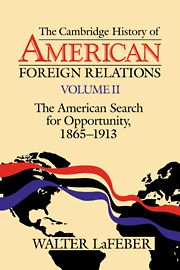Book contents
- Frontmatter
- 1 Springboards and strategies
- 2 The second Industrial Revolution at home and abroad
- 3 Race for empire
- 4 “America Will Take This Continent in Hand Alone”
- 5 Crossing the oceans
- 6 1893–1896: chaos and crises
- 7 The empire of 1898 – and upheaval
- 8 Pacific empire – and upheaval
- 9 Theodore Roosevelt: conservative as revolutionary
- 10 William Howard Taft and the age of revolution
- Conclusion: The 1865–1913 Era Restated
- Bibliographic Essay
- Index
- THE CAMBRIDGE HISTORY OF AMERICAN FOREIGN RELATIONS
- References
6 - 1893–1896: chaos and crises
Published online by Cambridge University Press: 28 March 2008
- Frontmatter
- 1 Springboards and strategies
- 2 The second Industrial Revolution at home and abroad
- 3 Race for empire
- 4 “America Will Take This Continent in Hand Alone”
- 5 Crossing the oceans
- 6 1893–1896: chaos and crises
- 7 The empire of 1898 – and upheaval
- 8 Pacific empire – and upheaval
- 9 Theodore Roosevelt: conservative as revolutionary
- 10 William Howard Taft and the age of revolution
- Conclusion: The 1865–1913 Era Restated
- Bibliographic Essay
- Index
- THE CAMBRIDGE HISTORY OF AMERICAN FOREIGN RELATIONS
- References
Summary
The United States drive to become the worlds most powerful nation climaxed successfully in the generation that came to power during and immediately after the Spanish-American War of 1898. The success had been long in forming, but the catalyst was the 1873–97 depression and, especially, the economic crisis of 1893–7 that transformed a long era of deflation into a full-blown economic depression. The post-1898 American empire was a product of the pre-1897 chaos at home. As we have seen, the crisis was triggered by the technological and managerial advances of the Second Industrial Revolution, advances that were exemplified by Carnegie’s policy of “running hard” to compete and indeed dominate market share. By the 1890s the Second Industrial Revolution, by all odds the most important event in American history between 1865 and 1914, had already begun spinning off a new, extracontinental foreign policy whose voices were Seward’s and Blaine’s especially. Culture (as manifested in the missionary movement), ideas (as seen in social Darwinism), and politics (as exemplified by an evolving Republican party and its fresh-found interest in reciprocity), as well as foreign policy had to adapt to the industrial changes.
American and Roman Empires
By 1893 the social trauma was becoming pronounced. Even the 1877 general strike and the 1886 Haymarket Riot paled in comparison. The percentage of unemployed in the total labor force of the manufacturing and transportation sectors has been estimated at about 4 percent in 1892, doubling to 9.6 percent in a year, and nearly doubling again to 16.7 percent in 1894.
- Type
- Chapter
- Information
- The Cambridge History of American Foreign Relations , pp. 103 - 128Publisher: Cambridge University PressPrint publication year: 1993



